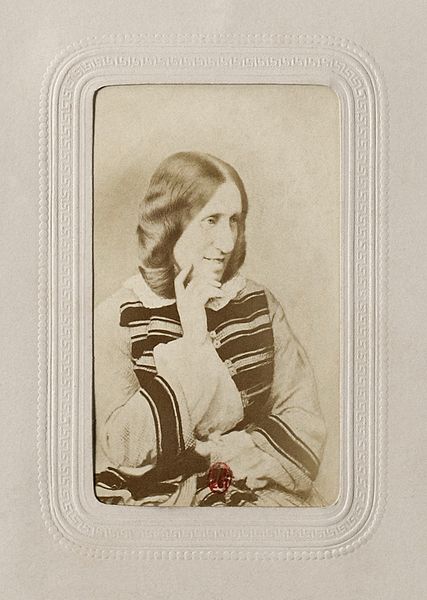George Henry Lewes was an English philosopher and critic of literature and theatre. He was also an amateur physiologist. American feminist Margaret Fuller called Lewes a "witty, French, flippant sort of man". He became part of the mid-Victorian ferment of ideas which encouraged discussion of Darwinism, positivism, and religious skepticism. However, he is perhaps best known today for having openly lived with Mary Ann Evans, who wrote under the pen name George Eliot, as soulmates whose lives and writings were enriched by their relationship, though they never married each other.
George Henry Lewes
William Makepeace Thackeray, Mr and Mrs George Henry Lewes with Thornton Leigh Hunt, date unknown, National Portrait Gallery, London
Replica by François D'Albert Durade, George Eliot (Mary Ann Evans), oil on canvas, 1849–1886, National Portrait Gallery
Grave of George Henry Lewes in Highgate Cemetery
Mary Ann Evans, known by her pen name George Eliot, was an English novelist, poet, journalist, translator, and one of the leading writers of the Victorian era. She wrote seven novels: Adam Bede (1859), The Mill on the Floss (1860), Silas Marner (1861), Romola (1862–1863), Felix Holt, the Radical (1866), Middlemarch (1871–1872) and Daniel Deronda (1876). As with Charles Dickens and Thomas Hardy, she emerged from provincial England; most of her works are set there. Her works are known for their realism, psychological insight, sense of place and detailed depiction of the countryside. Middlemarch was described by the novelist Virginia Woolf as "one of the few English novels written for grown-up people" and by Martin Amis and Julian Barnes as the greatest novel in the English language.
Eliot (Mary Ann Evans) in 1850
Portrait of George Eliot by Samuel Laurence, c. 1860
Photograph (albumen print) of George Eliot, c. 1865
Blue plaque, Holly Lodge, 31 Wimbledon Park Road, London







